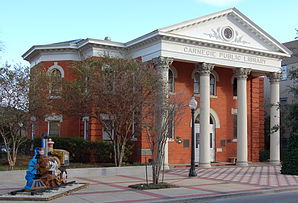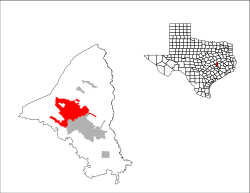Bryan (Texas)
| Bryan | |
|---|---|
 Brazos County Courthouse |
|
| Location of Bryan in Texas | |
| Basic data | |
| Foundation : | 1871 |
| State : | United States |
| State : | Texas |
| County : | Brazos County |
| Coordinates : | 30 ° 40 ′ N , 96 ° 22 ′ W |
| Time zone : | Central ( UTC − 6 / −5 ) |
| Residents : | 76,201 (as of 2010) |
| Population density : | 679.8 inhabitants per km 2 |
| Area : | 112.3 km 2 (approx. 43 mi 2 ) of which 112.1 km 2 (approx. 43 mi 2 ) is land |
| Height : | 108 m |
| Postcodes : | 77801-77803, 77807, 77808 |
| Area code : | +1 979 |
| FIPS : | 48-10912 |
| GNIS ID : | 1353099 |
| Website : | www.bryantx.gov |
| Mayor : | Mark Conlee |
 The Bryan Carnegie Library public library , listed on the NRHP with number 76002009 |
|
Bryan is the district capital and seat of the county seat of Brazos County in the US state of Texas in the United States . The city motto is: The Good Life, Texas Style .
geography
Bryan is near the geographic center of the county, about 150 km north-northwest of Houston , 270 km northeast of San Antonio, and nearly the same distance south of Dallas . The city has a total area of 112.3 km², of which 0.2 km² is water.
traffic
The place has connections to the highways 6 , 21 and 190 , to the farm roads 158, 1179, 1687 and 1688 as well as connections to the Missouri Pacific Railroad and the Southern Pacific Railroad .
history
The settlement of the present city area began around 1820 by members of the colony around Stephen F. Austin . In 1859, when the Houston and Texas Central Railroad moved its rails through this area, Austin's nephew William Joel Bryan pushed the settlement further. The place, which was incorporated as a city in 1872, was named after him. The first post office opened in 1866. Texas A&M College opened in 1876 and the Bryan Independent School District was formed a year later .
In 1884 the population had risen to 3,000 and in 1889 the electrification and construction of the urban water supply began. In 1900 Bryan got connection to a second railway company, the International Great Northern Railroad and the population had risen to 3,589. In 1902, the Carnegie Library public library was opened. It was founded by a $ 10,000 trust from Andrew Carnegie , a Scottish industrialist, steel tycoon, and philanthropist . In the next few years the number of inhabitants rose to 4,132 (in 1910), 6,307 (in 1920), 7,814 (in 1930) and 11,842 (in 1940).
Demographics
| Population development | |||
|---|---|---|---|
| Census | Residents | ± in% | |
| 1900 | 3589 | - | |
| 1910 | 4132 | 15.1% | |
| 1920 | 6307 | 52.6% | |
| 1930 | 7814 | 23.9% | |
| 1940 | 11,842 | 51.5% | |
| 1950 | 18,072 | 52.6% | |
| 1960 | 27,542 | 52.4% | |
| 1970 | 33,719 | 22.4% | |
| 1980 | 44,337 | 31.5% | |
| 1990 | 55.002 | 24.1% | |
| 2000 | 65,660 | 19.4% | |
| 2010 | 76.201 | 16.1% | |
| 1900-2010 | |||
According to the 2000 census, 65,660 people lived here in 23,759 households and 14,873 families. The population density was 584.9 inhabitants per km ². The racial the population was composed of 64.65% White, 17.72% African American, 0.40% Native American, 1.65% Asian, 0.08% Pacific Islander, and 13.32% other ethnic groups. About 2.17% were mixed race and 27.83% of the population were Hispanic or Latino of any race.
Of the 23,759 households, 32.3% had children under the age of 18 living with them. 44.2% of them were married couples living together. 14.0% were single mothers and 37.4% were non-families. 26.1% of all households were single households and 7.7% had people living there who were 65 years of age or older. The average household size was 2.65 and the average family size was 3.27.
27.0% of the population were under 18 years old, 18.1% 18 to 24, 29.8% 25 to 44, 15.8% 45 to 64, and 9.3% who were 65 years of age or older . The median age was 28 years. For every 100 females of all age groups, there were 99.2 males. For every 100 women aged 18 and over there were 95.7 men.
The median income for a household in the 31,672 USD , and the median income for a family 41,433 USD. Males had a median income of $ 29,780 versus $ 22,428 for females. The per capita income was $ 15,770. 22.3% of the population and 15.5% of families are below the poverty line. Of these, 27.0% were children and adolescents under 18 years of age and 11.7% were 65 or older.
sons and daughters of the town
- Robert Byron Bird (* 1924), chemical engineer
- Jack Kingston (born 1955), politician
- David Konderla (* 1960), Roman Catholic clergyman, Bishop of Tulsa
- Cat Rambo (* 1963), science fiction and fantasy writer
- Jocelyn McCauley (* 1988), triathlete
- Raini Rodriguez (* 1993), actress
- Annie Wang (* 2002), chess player
See also
- List of cities in Texas
- List of entries on the National Register of Historic Places in Brazos County
Individual evidence
- ^ Extract from the National Register of Historic Places . Retrieved March 13, 2011
- ↑ US Census data to 2010 . Retrieved October 12, 2012
Web links
- Bryan in the Handbook of Texas , (Eng.)
- Bryan (Texas) stats from city-data , (engl.)
